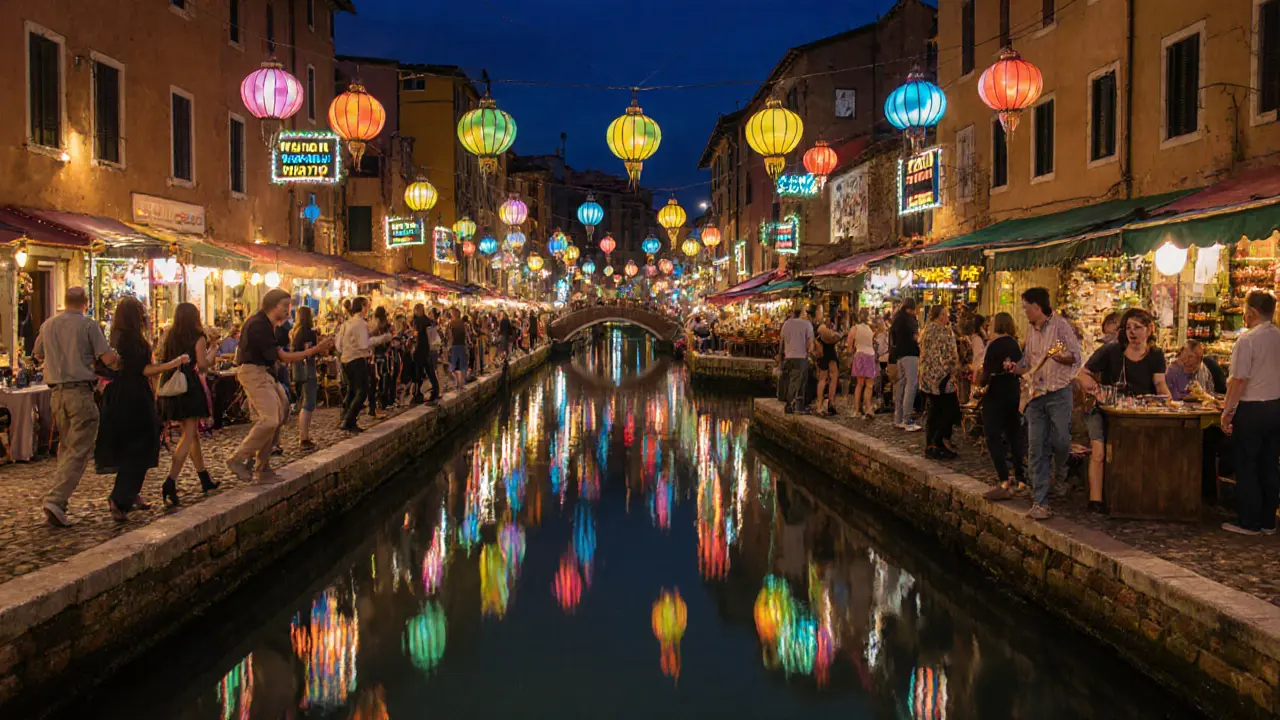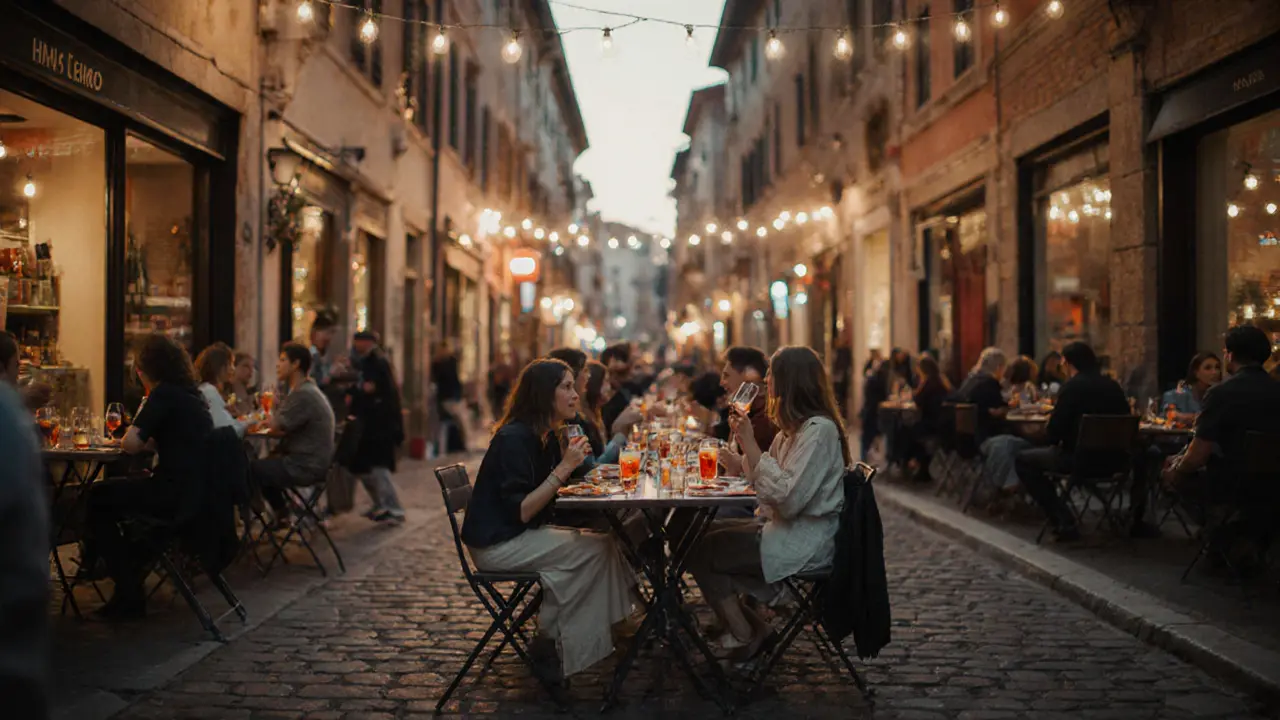When the sun goes down in Milan, the city doesn’t sleep-it switches gears.
Forget the daytime fashion shows and designer boutiques. After dark, Milan becomes a pulsing mix of hidden speakeasies, rooftop lounges, underground clubs, and late-night eateries that keep the energy alive until dawn. This isn’t just about partying. It’s about the rhythm of the city-how locals unwind, how visitors find their spot, and where the real vibe happens after 10 p.m.
Brera: Where the Night Starts with Aperitivo
If you want to start your night like a Milanese, head to Brera. This neighborhood is the heart of the city’s aperitivo culture. Around 7 p.m., the streets fill with people holding glasses of Aperol Spritz or Negroni, nibbling on free snacks that come with your drink. Places like Bar Basso are legendary-not just for their cocktails, but for inventing the Negroni Sbagliato. The vibe here is relaxed, stylish, and never rowdy. You’ll see artists, designers, and tourists all mingling at small tables under string lights.
Don’t miss La Cerva, a tiny wine bar with over 200 Italian labels. The staff know their wines and won’t push you toward the most expensive bottle. They’ll ask what you like and guide you. It’s the kind of place you’ll remember long after you leave.
Navigli: Canals, Cocktails, and Open-Air Parties
By 9 p.m., the canal-side bars of Navigli come alive. This area, once a working port, is now a long stretch of outdoor seating, live music, and colorful lights reflecting off the water. The crowd here is younger, more casual, and always on the move.
Bar Basso Navigli is the sister spot to the original in Brera-same quality, more space. But if you want something louder, try La Baita. It’s a converted warehouse with a massive outdoor terrace, DJs spinning indie and house, and a menu that mixes Italian snacks with global street food. The beer selection is solid, and the cocktails are creative without being pretentious.
On weekends, the whole canal area turns into a street festival. No tickets, no cover. Just music, laughter, and people dancing on the cobblestones. Bring comfortable shoes. You’ll be walking a lot.
Porta Romana: The Clubbing Heartbeat
If you’re looking for clubs that go past 3 a.m., Porta Romana is your destination. This neighborhood is where Milan’s electronic music scene lives. It’s not touristy. It’s not flashy. It’s raw, real, and loud.
La Scala is the oldest underground club in the city, opened in 1987. The walls are still covered in old flyers, the sound system is top-tier, and the DJs are locals who’ve been spinning for 20 years. Entry is €10, no dress code, and no one cares if you’re wearing sneakers. The vibe? Think Berlin meets Milan-minimalist, focused on the music.
For a more polished experience, Magazzini Generali is a multi-level venue in a converted warehouse. It has three rooms: one for techno, one for house, and one for live acts. The lighting is moody, the crowd is mixed, and the drinks are priced fairly. You’ll find students, professionals, and travelers all in the same room, dancing without judgment.

Corso Como: Design, Drinks, and Late-Night Dining
Corso Como is where Milan’s creative elite hang out after hours. It’s not a club. It’s not a bar. It’s a cultural hub that turns into a nightlife spot after dark. The place to be is Corso Como 10-a design store by day, a restaurant and bar by night.
The menu here is Italian with global twists: truffle risotto, grilled octopus, and tiramisu made with espresso from a local roaster. The wine list is curated by a sommelier who works with small producers. You won’t find Chianti on the menu. You’ll find something from Sicily, Friuli, or even Slovenia.
It’s open until 2 a.m. on weekends, and the terrace is the best spot to watch the city lights. The crowd is older than in Navigli, more refined than in Porta Romana. If you want to end your night with a conversation instead of a dance, this is your place.
Isola: The New Frontier for Night Owls
Isola used to be an industrial zone. Now, it’s where the new generation of Milanese is building their nightlife. It’s gritty, authentic, and full of surprises.
Bar Basso Isola (yes, they opened a third location) is here, but so are smaller gems like Bar 100-a no-frills bar with a 20-year-old jukebox, cheap beer, and a wall covered in handwritten notes from regulars. The owner, Marco, remembers everyone’s name. He’ll ask if you tried the new bitter liqueur he imported from Calabria.
For food, La Cucina di Nonna serves homemade pasta until 1 a.m. The ragù is slow-cooked for 12 hours. The gnocchi are made fresh every day. And the wine? Bottles from the owner’s family vineyard in Piedmont. No menu. You just tell him what you’re in the mood for, and he brings it.
What to Know Before You Go
- Timing matters. Bars don’t get busy until 9 p.m. Clubs don’t heat up until 11 p.m. Show up at 8 p.m. and you’ll be alone.
- Cover charges vary. In Brera and Navigli, you pay for your drink and get snacks. In clubs, expect €10-€20 entry, often including one drink.
- Dress code is relaxed. You won’t be turned away for jeans and a t-shirt. But if you’re going to Corso Como or a high-end lounge, skip the flip-flops.
- Transportation ends early. The metro stops at 1 a.m. on weekdays, 2 a.m. on weekends. Taxis are easy to find, but Uber isn’t legal here. Use FreeNow or local apps.
- Water is free. Ask for “acqua del rubinetto.” Italians don’t charge for tap water. You’ll save money and help the environment.

Where to Eat After the Club
Most clubs close around 3 a.m., and hunger hits hard. Don’t go to McDonald’s. Go to Trattoria da Vittorio in the Porta Venezia area. It’s open 24/7. Their panzerotti are fried to order, filled with mozzarella and tomato, and cost €4.50. Or head to La Focacceria in the city center-they serve hot focaccia with prosciutto and arugula until 5 a.m. It’s the real post-party fuel.
What to Skip
- Tourist traps near Duomo. Bars that charge €15 for a beer and play Top 40 music. They’re loud, overpriced, and empty of local energy.
- Clubs that advertise on Instagram. If a place has a photo shoot every night and a DJ from Ibiza, it’s probably not for locals. Skip it.
- Waiting in line at the “most famous” spot. Milan’s best nights are found in places you won’t find on a travel blog.
Final Tip: Ask Locals
Walk into any bar after 10 p.m., order a drink, and say, “Dove va la gente stasera?” (Where are people going tonight?). Nine times out of ten, you’ll get a real answer. A hidden courtyard bar. A secret jazz club. A friend’s apartment with a turntable and a keg. That’s Milan’s nightlife. Not the brochure. The real thing.
What’s the best night to go out in Milan?
Friday and Saturday nights are the busiest, especially in Navigli and Porta Romana. But if you want a more authentic, less crowded experience, go on a Thursday. The bars are lively, the clubs are still open, and the crowd is mostly locals. Sunday nights in Brera are surprisingly good too-quieter, more relaxed, perfect for a slow end to the weekend.
Is Milan nightlife safe for solo travelers?
Yes, Milan is one of the safest major European cities for solo travelers at night. The main areas-Brera, Navigli, Porta Romana, and Corso Como-are well-lit, patrolled, and full of people. Avoid isolated side streets after midnight, especially near the train station. But stick to the main nightlife zones, and you’ll be fine. Locals are friendly and will help if you look lost.
Do I need to make reservations for bars or clubs?
For most bars and casual spots, no. Walk in, grab a seat, and order. But for Corso Como 10 or popular clubs like Magazzini Generali on weekends, it’s smart to book ahead. You can do it online or call directly. Some places don’t take reservations, but they’ll let you know if there’s a wait. Don’t assume you’ll get in without a line.
How much should I budget for a night out in Milan?
You can have a great night for €30-€50. Aperitivo (drink + snacks) costs €12-€18. A club entry with one drink is €15-€20. A late-night pasta meal is €10-€15. Skip the overpriced cocktails and tourist spots, and you’ll stretch your money. If you’re going out every night, aim for €40-€60 per night.
Are there any LGBTQ+-friendly spots in Milan?
Yes. Milan has a strong LGBTQ+ scene. Bar Basso and La Cerva are welcoming to everyone. For a dedicated queer space, head to Il Covo in the Navigli area-it’s a bar, club, and cultural center with drag shows, live music, and themed nights. It’s open every night and has a friendly, inclusive crowd. The city’s annual Pride parade in June is one of the biggest in Italy.
What’s the difference between aperitivo and happy hour?
Happy hour is just a discount on drinks. Aperitivo is a ritual. You pay for one drink, and you get a buffet of snacks-cold cuts, cheese, salads, mini-pizzas, even risotto balls. It’s not a promotion. It’s part of the culture. Most places start at 7 p.m. and go until 9:30 p.m. You can eat your way through the whole spread and still feel full. It’s the best value in Milan nightlife.
